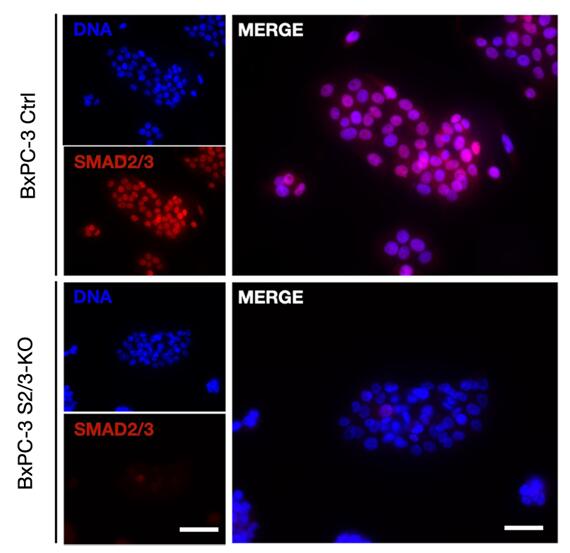Cas9 Stable Cell Line - BXPC-3
Cat.No. : CSC-RO0032 Host Cell: BXPC-3
Size: >1x10^6 cells/vial Validation: T7 Endonuclease I assay
Cat.No. : CSC-RO0032 Host Cell: BXPC-3
Size: >1x10^6 cells/vial Validation: T7 Endonuclease I assay
| Cat. No. | CSC-RO0032 |
| Product Type | Cas9 overexpression stable cell line |
| Introduction | Clustered regularly interspaced palindromic repeats (CRISPR)/Cas9 is a gene-editing technology that contains two essential components: a guide RNA (gRNA) to match a target gene, and the Cas9 (CRISPR-associated protein 9) endonuclease which causes a double-stranded DNA break, allowing modifications to the genome via nonhomologous end joining (NHEJ) or homology-directed repair (HDR). |
| Cell Line Information | BXPC-3-Cas9 cell line is engineered to stably overexpress Cas9 nuclease. The Cas9 nuclease in BXPC-3-Cas9 cell line has been functionally validated using T7 Endonuclease I assay. In combination with separately transfected sgRNAs, BXPC-3-Cas9 cell line can be used to efficiently generate targeted genomic modifications including gene knockout, gene knockin, gene mutagenesis, gene tagging etc. It is also an ideal cell line model for sgRNA screening and validation, either individually or in pools. |
| Target Gene | Cas9 |
| Host Cell | BXPC-3 |
| Applications | 1) CRISPR genome editing, such as gene knockout (KO), gene knockin (KI), gene mutagenesis, gene tagging etc. 2) High-throughput sgRNA screening and validation |
| Quality Control | 1) T7E1 assay 2) Mycoplasma detection |
| Size Form | One vial of frozen cells, typically >1x10^6 cells/vial |
| Shipping | Dry ice |
| Storage | Liquid nitrogen |
| Species | Homo sapiens (Human) |
| Mycoplasma | Negative |
| Format | One frozen vial containing millions of cells |
| Storage | Liquid nitrogen |
| Safety Considerations |
The following safety precautions should be observed. 1. Use pipette aids to prevent ingestion and keep aerosols down to a minimum. 2. No eating, drinking or smoking while handling the stable line. 3. Wash hands after handling the stable line and before leaving the lab. 4. Decontaminate work surface with disinfectant or 70% ethanol before and after working with stable cells. 5. All waste should be considered hazardous. 6. Dispose of all liquid waste after each experiment and treat with bleach. |
| Ship | Dry ice |
TGF-β signaling is essential in pancreatic ductal adenocarcinoma (PDAC) development, altered in all PDAC cases as one of four major pathways. Researchers demonstrate the crucial role of SMAD2/3 in pancreatic ductal adenocarcinoma (PDAC) progression, particularly in SMAD4-null contexts. By investigating TGF-β signaling in PDAC cells lacking SMAD4, they reveal SMAD2/3's oncogenic effects, influencing collective migration through FAK and Rho/Rac signaling pathways. RNA-sequencing analyses unveil a TGF-β gene signature linked to aggressive behavior, facilitated by SMAD2/3 activation. Additionally, clinical data suggests that SMAD4-negative tumors with elevated phospho-SMAD2 levels exhibit increased aggressiveness and poorer prognosis. These findings underscore the complex interplay between TGF-β signaling components in PDAC, highlighting SMAD2/3 as potential therapeutic targets.
 Figure 1. A double SMAD2/SMAD3 knockout BxPC-3 (SMAD4-negative) pancreatic cancer cell line was generated. SMAD protein expression and localization in response to TGF-β treatment were assessed. Altered SMAD2/3 levels and distribution were observed in knockout cells compared to controls, providing insights into TGF-β signaling in pancreatic cancer progression. (Bertrand-Chapel A, et al., 2022)
Figure 1. A double SMAD2/SMAD3 knockout BxPC-3 (SMAD4-negative) pancreatic cancer cell line was generated. SMAD protein expression and localization in response to TGF-β treatment were assessed. Altered SMAD2/3 levels and distribution were observed in knockout cells compared to controls, providing insights into TGF-β signaling in pancreatic cancer progression. (Bertrand-Chapel A, et al., 2022)
Utilizing Creative Biogene's Cas9 Stable Cell Line-BXPC-3 streamlines the process of SMAD2/SMAD3 gene knockout experiments. This stable cell line is directly amenable to CRISPR/Cas9 gene editing technology, facilitating the rapid generation of SMAD2/SMAD3 knockout cell lines, thereby saving time and resources. Such cell lines can be instrumental in investigating the TGF-β signaling pathway and its implications in pancreatic cancer progression, enhancing the convenience and efficiency of related disease research endeavors.

Our promise to you:
Guaranteed product quality, expert customer support.
 24x7 CUSTOMER SERVICE
24x7 CUSTOMER SERVICE
 CONTACT US TO ORDER
CONTACT US TO ORDER